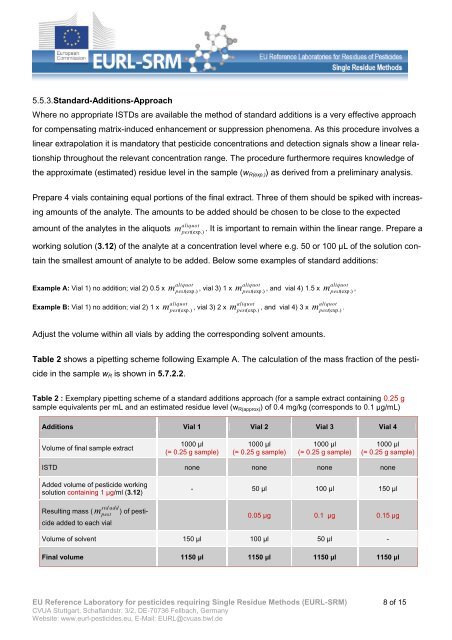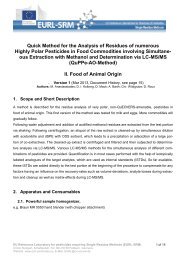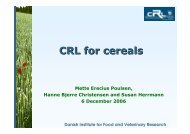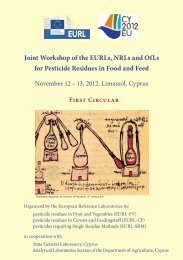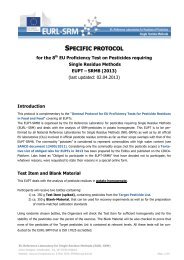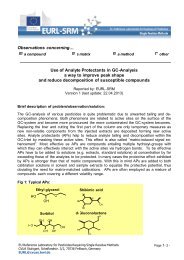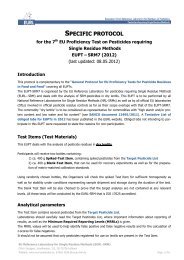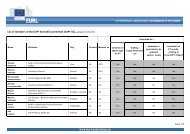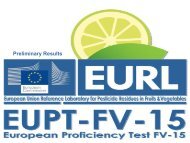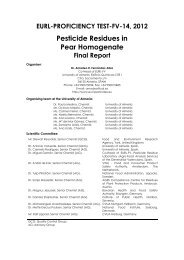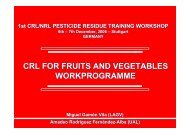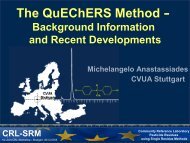QuPPe-AO - EURL | Residues of Pesticides
QuPPe-AO - EURL | Residues of Pesticides
QuPPe-AO - EURL | Residues of Pesticides
You also want an ePaper? Increase the reach of your titles
YUMPU automatically turns print PDFs into web optimized ePapers that Google loves.
5.5.3.Standard-Additions-Approach<br />
Where no appropriate ISTDs are available the method <strong>of</strong> standard additions is a very effective approach<br />
for compensating matrix-induced enhancement or suppression phenomena. As this procedure involves a<br />
linear extrapolation it is mandatory that pesticide concentrations and detection signals show a linear rela-<br />
tionship throughout the relevant concentration range. The procedure furthermore requires knowledge <strong>of</strong><br />
the approximate (estimated) residue level in the sample (wR(exp.)) as derived from a preliminary analysis.<br />
Prepare 4 vials containing equal portions <strong>of</strong> the final extract. Three <strong>of</strong> them should be spiked with increas-<br />
ing amounts <strong>of</strong> the analyte. The amounts to be added should be chosen to be close to the expected<br />
amount <strong>of</strong> the analytes in the aliquots<br />
aliquot<br />
m pest(exp<br />
.)<br />
. It is important to remain within the linear range. Prepare a<br />
working solution (3.12) <strong>of</strong> the analyte at a concentration level where e.g. 50 or 100 µL <strong>of</strong> the solution con-<br />
tain the smallest amount <strong>of</strong> analyte to be added. Below some examples <strong>of</strong> standard additions:<br />
aliquot<br />
aliquot<br />
aliquot<br />
Example A: Vial 1) no addition; vial 2) 0.5 x m pest(exp<br />
.) , vial 3) 1 x m pest(exp<br />
.) , and vial 4) 1.5 x m pest(exp<br />
.) ,<br />
aliquot<br />
aliquot<br />
aliquot<br />
Example B: Vial 1) no addition; vial 2) 1 x m pest(exp<br />
.) , vial 3) 2 x m pest(exp<br />
.) , and vial 4) 3 x m pest(exp<br />
.) .<br />
Adjust the volume within all vials by adding the corresponding solvent amounts.<br />
Table 2 shows a pipetting scheme following Example A. The calculation <strong>of</strong> the mass fraction <strong>of</strong> the pesti-<br />
cide in the sample wR is shown in 5.7.2.2.<br />
Table 2 : Exemplary pipetting scheme <strong>of</strong> a standard additions approach (for a sample extract containing 0.25 g<br />
sample equivalents per mL and an estimated residue level (wR(approx)) <strong>of</strong> 0.4 mg/kg (corresponds to 0.1 µg/mL)<br />
Additions Vial 1 Vial 2 Vial 3 Vial 4<br />
Volume <strong>of</strong> final sample extract<br />
1000 µl<br />
(= 0.25 g sample)<br />
1000 µl<br />
(= 0.25 g sample)<br />
1000 µl<br />
(= 0.25 g sample)<br />
EU Reference Laboratory for pesticides requiring Single Residue Methods (<strong>EURL</strong>-SRM)<br />
CVUA Stuttgart, Schaflandstr. 3/2, DE-70736 Fellbach, Germany<br />
Website: www.eurl-pesticides.eu, E-Mail: <strong>EURL</strong>@cvuas.bwl.de<br />
1000 µl<br />
(= 0.25 g sample)<br />
ISTD none none none none<br />
Added volume <strong>of</strong> pesticide working<br />
solution containing 1 µg/ml (3.12)<br />
std add<br />
Resulting mass ( m pest ) <strong>of</strong> pesticide<br />
added to each vial<br />
- 50 µl 100 µl 150 µl<br />
0.05 µg 0.1 µg 0.15 µg<br />
Volume <strong>of</strong> solvent 150 µl 100 µl 50 µl -<br />
Final volume 1150 µl 1150 µl 1150 µl 1150 µl<br />
8 <strong>of</strong> 15


